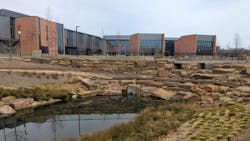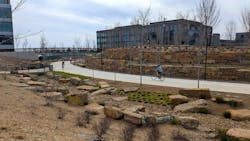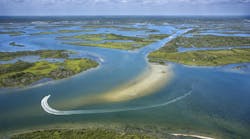Big nature philosophy guides Walmart campus design
Key Highlights
- The campus features bioswales, rain gardens, and the Green Groove waterway to capture, treat and reuse stormwater, reducing reliance on conventional infrastructure.
- North and South Lakes serve as stormwater reservoirs, collecting runoff and providing over 50 million gallons annually for irrigation and wildlife habitats.
- Low impact design elements like grass pavers and native plants minimize impervious surfaces and heat island effects, promoting sustainability.
The Walmart Home Office campus, located on 350-acres in Bentonville, Arkansas, prioritizes sustainability and responsible water management. Guided by the “Big Nature” philosophy, which recognizes every landscape as part of a larger ecological network, the campus design incorporates advanced stormwater management and treatment strategies to mimic natural, predevelopment hydrology and significantly reduces environmental impacts.
To support Walmart’s sustainability goals and improve stormwater quality, the campus utilizes a treatment train that layers multiple green infrastructure solutions. Key features include bioswales, rain gardens, and a centralized vegetated waterway called the “Razorback Greenway Trail.” The bioswales and rain gardens, located strategically throughout the campus, are designed to capture as well as clean stormwater before it enters the sewer systems. They also play a key part of the sustainable water management and serve as part of the efforts to control erosion on the campus.
“A key example of this regenerative approach is Walmart’s leadership in environmental sustainability — demonstrated through its stewardship of natural resources and efforts to minimize environmental impact,” said Seth Roy, group director, Home Office Campus Design and Construction at Walmart.
The civil engineering design included a drainage system to direct a substantial volume of stormwater through the Razorback Greenway Trail prior to discharge into the North and South Lakes, promoting natural pollutant filtration and decreasing the demand on conventional stormwater infrastructure. This approach also achieves significant cost savings by minimizing the size and amount of conventional stormwater piping.
Together, these features efficiently manage stormwater, filter pollutants, provide non-potable water for reuse, and ensure water quality is maintained before it is either reintroduced to the campus or released into adjacent creeks. This integrated approach exemplifies Walmart’s core sustainability initiatives for water stewardship and sustainable infrastructure by advancing resilient, environmentally responsible water management at scale.
“The implementation of low impact design (LID), including bioswales along key roadways and active pedestrian corridors, effectively attenuates stormwater runoff and reduces infrastructure costs across the campus,” said Shaun Cessna, principal and team director in the Civil Engineering Group at Walter P Moore.
The Walmart Home Office campus master plan provides a holistic approach to water management, advancing both environmental responsibility and water resiliency for Walmart as well as the City of Bentonville. The city was forced to increase water rates by 100% in March 2025 due to increased demand from new homes in concert with an existing infrastructure that loses 54% of its water due to leaks, according to a 2024 water rate study.
Importance of bioswales
By providing storage, attenuating peak flows, and treating developed flows locally prior to entering the storm sewer system, the bioswales are a major contributor to the sustainable water management for the Walmart campus.
“The campus landscape incorporates native and drought-tolerant plants to reduce water usage, while advanced stormwater systems help manage runoff and improve water quality,” said Roy. “Features like bioswales, retention lakes, and the Razorback Greenway — a hiking and biking trail that runs through the campus and connects Town Branch Creek to Osage Park — reflect this integrated, eco-conscious design.”
Located along major roadways, the trail system, and drainage paths, these bioswales provide critical erosion control and stormwater management. The majority of the paved areas on campus are designed to drain into bioswales, ensuring that every drop of water that lands on the campus, once it is properly treated, is reused as part of the irrigation system.
The bioswales help manage stormwater runoff, reduce infrastructure costs, provide local storage, and stormwater treatment before any water that lands on campus enters the storm sewer system for additional treatment. To further support operational efficiency, the bioswales and pass-through planters are designed for straightforward, low maintenance landscaping.
Sustainability and the Green Groove
From a civil engineering perspective, it was critical to integrate the environment into the campus design to reduce the campus’s carbon footprint. A key component of Walmart’s commitment to sustainability is the Razorback Greenway Trail that runs through the heart of the campus and acts as a natural waterway alongside a bike and pedestrian trail.
The stormwater collection systems convey and discharge the pretreated runoff to the Razorback Greenway Trail vegetated waterway. The Razorback Greenway Trail was planned not only as the hike and bike extension of the Razorback Trail, connecting Town Branch Creek to Osage Park, but also to serve as the backbone of the campus stormwater conveyance and water quality treatment systems.
The Razorback Greenway Trail uses vegetation to control water flow while concurrently purifying the water for reuse in the campus irrigation system by linking to the North and South campus lakes that collect stormwater. The Razorback Greenway Trail actively treats, aerates, and polishes every drop of water by removing pollutants and debris before directing it to the campus lakes. Because the Razorback Greenway Trail utilizes the natural landscape — as part of the Big Nature philosophy — it ensures the stormwater on campus is effectively managed while also protecting the environment.
“The Green Groove allows for the connection of multiple stormwater treatments to not only activate, aerate, polish, and deliver naturally treated and clean stormwater, but deliver it free of sediment, excess nutrients, contaminants, and debris, to the campus lakes and streams that serve the outfalls from the lakes,” said Erica Valdez, senior associate in the Civil Engineering Group at Walter P Moore.
Functional uses of LID
The Green Groove is a signature feature on the Walmart campus, exemplifying low impact development while reducing the need for conventional conveyance infrastructure, and serving as a valuable campus amenity. Additional features include:
- Bioswales: Enhance stormwater quality by filtering runoff, increasing time of concentration, and reducing downstream detention requirements. They effectively intercept and remove pollutants before water enters the storm sewer, detention system, and city infrastructure.
- Lake Detention Design: Strategically located lakes maintain natural drainage patterns and accommodate runoff from surrounding communities. The South Lake utilizes an OPTISystem with real time data to optimize stormwater storage and release, increasing capacity to help downstream flooding.
- Irrigation Design and Water Reuse: Stormwater from the campus and adjacent roadways are directed to campus lakes for storage and reuse in landscape irrigation. This approach eliminates the need for city supplied water for irrigation, resulting in significant cost savings.
- Landscaping: Extensive tree and plantings reduce the heat island effect, while mature trees relocated from the original site are preserved. Grass pavers are used throughout the campus to further reduce impervious cover.
Role of the North & South Lakes
The North and South Lakes play a vital role in reducing potable water use on the campus. Both lakes also collect stormwater and are connected to the campus irrigation system, significantly decreasing Walmart’s reliance on the city’s potable water supply for irrigation purposes.
“The Walmart Home Office campus takes a proactive approach to stormwater management, incorporating bioswales and over 13 acres of lakes designed to filter pollutants, supply non-potable water, and improve water quality before it’s discharged,” said Roy. “These lakes are expected to provide more than 50 million gallons of water annually for smart irrigation, rainwater reuse, and supporting local wildlife habitats.”
Designing the stormwater system to create the treatment train upstream of the campus lakes allows for further reduction of costly and maintenance-intensive infrastructure, such as lake aeration, chemical and biological controls to control algae blooms, and dredging. The lakes were designed to allow for settlement of solids to improve the water quality of the downstream tributaries.
Because the North and South lakes are engineered water bodies designed to temporarily store and manage stormwater, this allows for the controlled release of developed flow from the campus via a weather-actuated gate at the South Lake. This gate facilitates water reuse and detention storage overlap, prevents downstream flooding, and minimizes the impact from the developed campus on natural waterways such as Town Branch Creek and Osage Creek.
The lakes' wet bottoms and wetland planting allow for the final step in the water treatment train before being released into the creeks.
Water as a resource
A major component of the Walmart Home Office campus master plan was acting on the understanding of the importance of water as a resource. The need for planning for the most effective use of the water resources at the campus was an overarching goal.
This was accomplished by identifying the water resources to serve the campus, evaluating the risks from either too much or too little water, and planning for the management of the water resources on campus. Each provided the framework for understanding the cycle of water and how to provide mutually beneficial solutions for the campus, the community, and the environment.
“The foundation in engineering a more sustainable campus was understanding the site specific water supply sources, demands, and stresses from the development and the community,” said Charlie Penland, managing principal and director of Business Development in the Infrastructure Group at Walter P Moore.
To help understand these, a series of water mapping and water balance analyses for the Original Home Office located approximately a mile away identified the feasible options for on-site water collection, storage, and reuse as well as providing the critical information needed for LID features.
“As a regenerative company, Walmart is committed to restoring what it takes and leaving the world better than it found it. In collaboration with its consultants, Walmart has thoughtfully developed a dynamic and cohesive campus plan designed to inspire pride among associates, their families, and the Bentonville community,” said Roy.
Walter P Moore incorporated sustainable water management practices to ensure synergy between Walmart and the city of Bentonville in order to manage stormwater, reduce campus water usage, and improve the quality of water leaving the campus.
Editor's Note: After publication, the Green Groove was renamed to Razorback Greenway Trail. The article was updated to incorporate that name change on August 12, 2025.
About the Author
Ted Vuong
Ted Vuong, PE, LEED AP, ENV SP, is a managing principal at Walter P Moore.
Gus Leutermann
Gus Leutermann, PE, is a senior associate and senior civil engineer at Walter P Moore.





